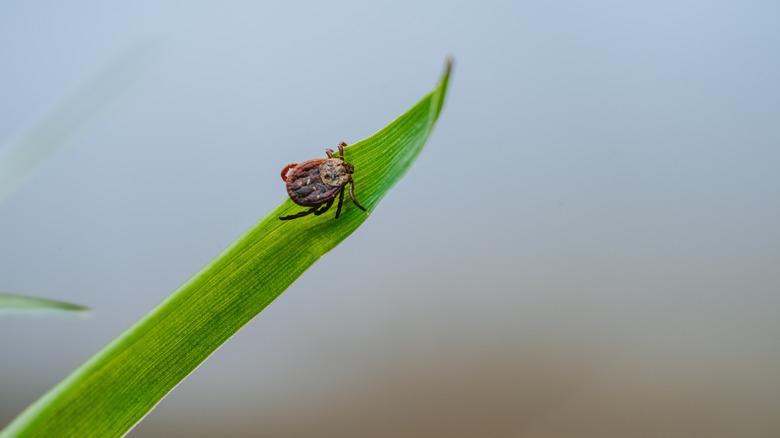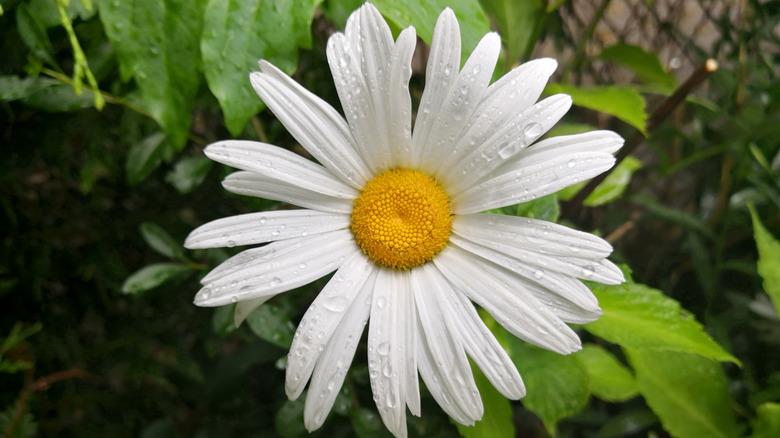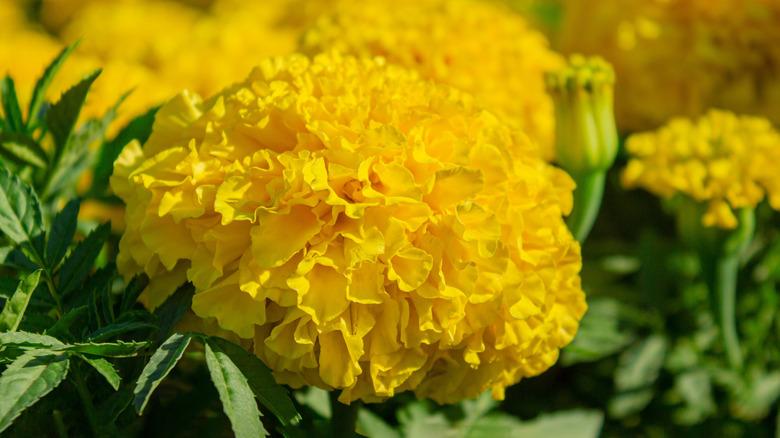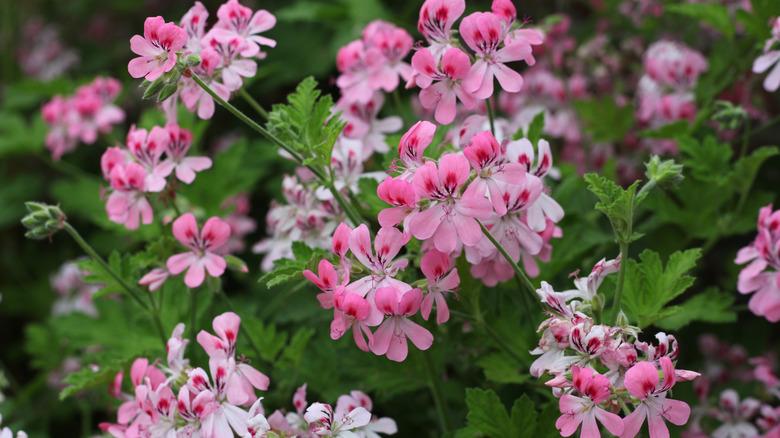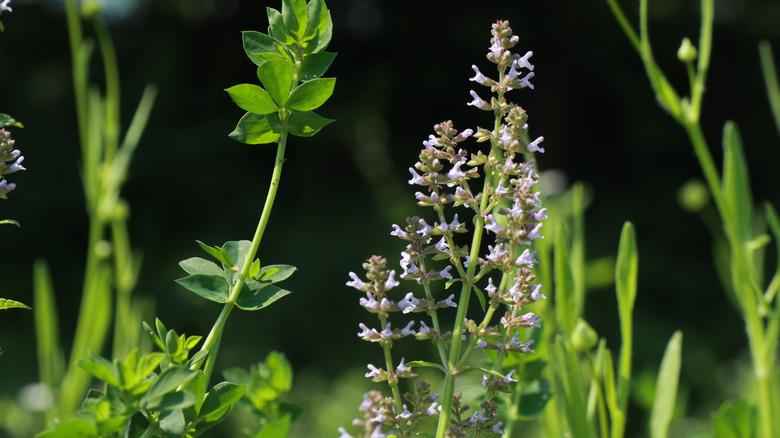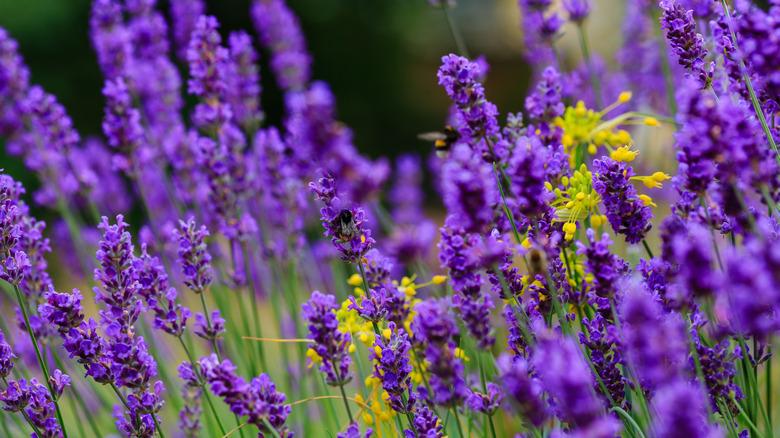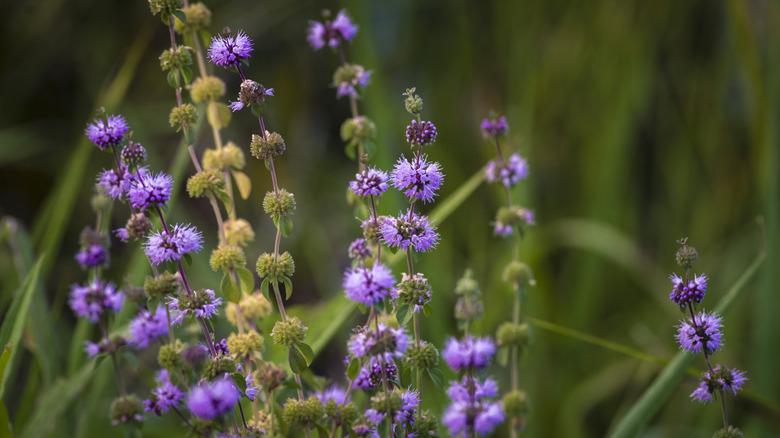9 Beautiful Plants That May Help Keep Fleas And Ticks Out Of Your Yard
There are many fun ways to incorporate a lively garden into your low-maintenance landscaping ideas for the backyard. You can create a gorgeous berry garden that can feed birds all winter long or set up your space as the perfect aesthetic backdrop for an outdoor dinner party. No matter what, a vibrant garden will be a great addition. Unless, of course, your backyard starts to become overrun by pests and bugs. Creepy critters are often an inevitable part of your landscaping, and while some are mere nuisances, others can pose real risks to your health, like fleas and ticks.
These unwanted backyard guests are tiny and known for getting their sustenance from the blood of their hosts. Flea bites can cause irritating and itchy bumps, and their saliva can result in allergic reactions. Tick bites, on the other hand, are typically painless. But unlike fleas, when they bite, they latch on and feed for days. Ticks can carry serious diseases, like Lyme disease, that are spread through their bite.
It's important to protect yourself and your pets from these common disease-carrying bugs. There are some chemical products that can help kill and/or deter fleas and ticks, but why not go au naturel and get a little more bang for your buck with some beautiful repellent plants instead? There are quite a few options that can not only up your garden's aesthetic, but may also deter fleas and ticks. Check out some of our favorites below.
Dalmatian chrysanthemum
Let's start the list with one of the most potent insect-repelling plants out there, the Dalmatian chrysanthemum (Tanacetum cinerariifolium). Grown in hardiness zones 5-9, this flower produces pyrethrum, a chemical compound that attacks insects like fleas' and ticks' nervous systems and ultimately doesn't just repel them, but kills them, too. It's one of the oldest insecticides still in use and the ultimate natural way to keep these dangerous pests from your yard. Not only will they get the job done, but they also brighten up the garden with their lovely white and yellow colors and dainty appearance.
Marigolds
Though there is conflicting science on whether or not marigolds (Tagetes) can repel fleas or ticks and little to directly support that assertion, this gorgeous plant can still be an effective member of your pest-fighting garden. Marigolds don't necessarily repel ticks, but they do repel deer that carry ticks. They can help with keeping the pests from your yard by deterring their entrance to begin with. Marigolds' gorgeous, vibrant colors will also bring great color to your garden. They're easy-to-grow annuals that'll do well in hardiness zones 3 to 10.
Rose geraniums
Rose geranium (Pelargonium graveolens) plants, grown in hardiness zones 10-11, have shown some possible flea and tick repellent properties, making them an option for your garden. They have five-petaled flowers that bloom in shades of pink and lavender, and their scent is said to calm nerves. While strolling through your garden, take a big whiff and know this plant is working to keep the pests away. It's important to note this plant is toxic to cats and dogs, though, so opt for a different option if you have pets.
Common sage
Common sage (Salvia officinalis) prefers full sun and well-drained soil, so make sure to keep it out of the shade. Like many others on this list, the strong scent of sage has given some indication that it may deter fleas and ticks. Sage grows upright in hardiness zones 4 to 10 with furry leaves that add visual interest to a garden. Its flowers will be bluish or pinkish purple and attract butterflies and bees. Getting hungry? You can also pluck sage leaves to cook in a variety of delicious meals.
Lemongrass
There's not yet a lot of hard science to back this one up, but there have been some promising studies. When ticks were presented with lemongrass essential oil, upon sniffing, they'd leave the area. Though more research is needed, lemongrass (Cymbopogon citratus) seems to be a good option as a repellent and grows well in hardiness zones 10-11. Its thin, blue-green leaves turn red in the fall, adding color to your yard. Lemongrass also has culinary uses, so while you repel fleas and ticks, you can also harvest it to add to your favorite soup, tea, or curry meal. One thing to keep in mind is that lemongrass can be considered toxic to people and animals, so please consult a physician or veterinarian before use.
Yarrow
Yarrow (Achillea millefolium) is a lovely aromatic perennial grown in hardiness zones 3 to 9 that can get up to three feet and is often used on the border of gardens to attract pollinators. The yarrow plant is gray-blue in color and has white or occasionally pink flowers. The essential oils from the yarrow plant has shown properties that repel ticks and its powder is often said to keep fleas away. Yarrow has been used frequently for many medicinal purposes, so it doesn't seem far-fetched that it could repel fleas and ticks as well.
According to the United States Department of Agriculture (USDA), yarrow has the potential to be invasive. Please check your local area to see if it is considered invasive in your region prior to planting.
Lavender
Ticks and fleas can be resistant to repellent products, which has led people to turn to natural alternatives like lavender (Lavendula) instead. Lavender is one of a handful of herbs that can help repel ticks and fleas from your yard with its strong scent. Though there isn't a lot of research to support this, there are many people who claim the herb works. This brightly colored plant will also attract beneficial pollinators, so there's no reason not to give it a try, especially if you live in hardiness zones 5 through 8.
Pennyroyals
Pennyroyal (Mentha pulegium) is a hardy plant from the mint family that can grow up to 12 inches in height. It grows as dense mats and can be used as ground cover. Along with treating digestive system issues, pennyroyal plants can deter fleas and ticks as well with their strong spearmint scent. Grown in hardy zones 6 to 9, in the summer, pennyroyals bloom with clusters of whorled purple flowers. The blooms' delicate appearance contrasts well with other plants in the garden. Though helpful as a pest repellent, exercise caution as pennyroyal can be toxic to people and pets. It is also considered moderately invasive in certain parts of the western United States. Please check if it is invasive in your region
Chamomile
Chamomile (Matricaria chamomilla L.) is well-known for its many medicinal purposes and is widely consumed as tea. Some studies have shown that it might be helpful beyond these already-known benefits as a tick repellent. A study published in the Journal of Zhejiang University Science B showed that exposure to chamomile resulted in tick death and a significantly decreased ability to lay eggs. The benefits of chamomile make it a great addition to a garden. Chamomile plants are easy to grow and are identifiable by their lovely white and yellow blooms. They're perfect for herb container gardening and go well with verbena and mint (both said to help deter fleas and ticks, also.)
